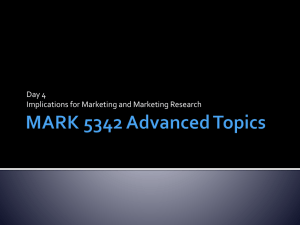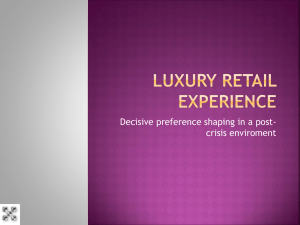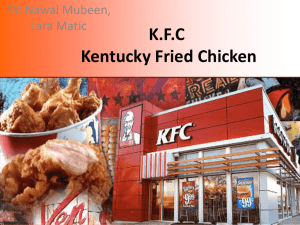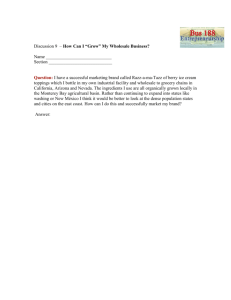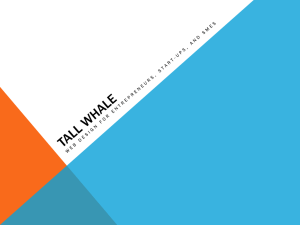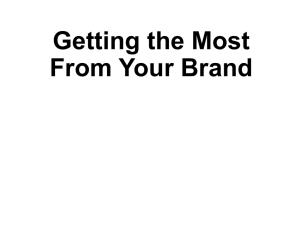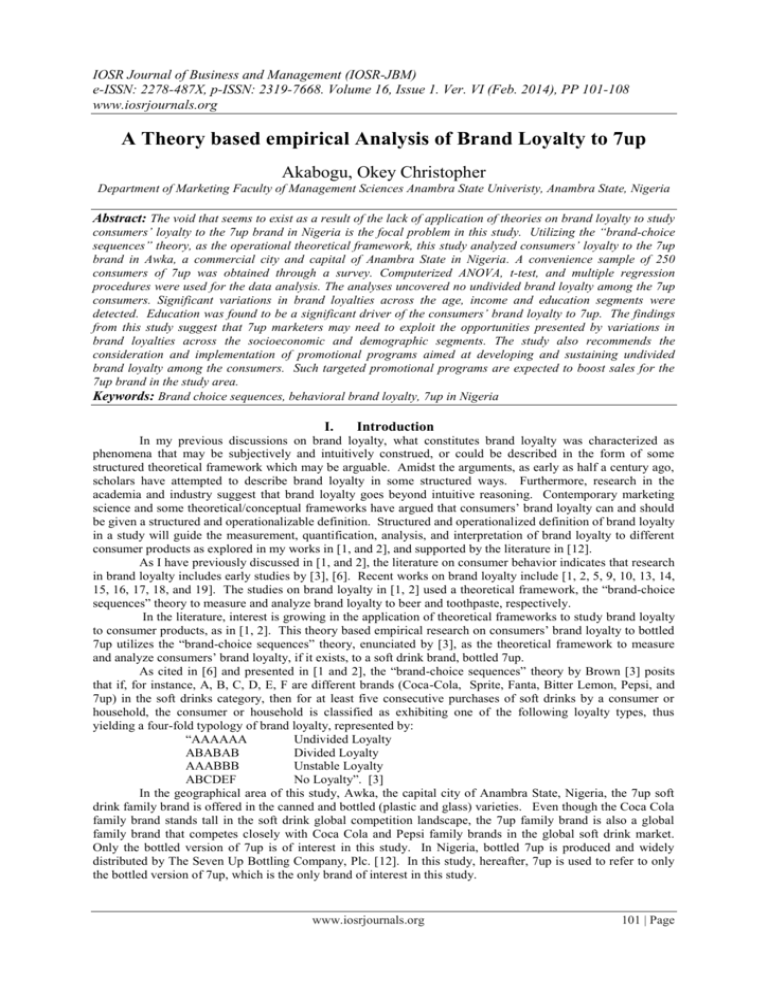
IOSR Journal of Business and Management (IOSR-JBM)
e-ISSN: 2278-487X, p-ISSN: 2319-7668. Volume 16, Issue 1. Ver. VI (Feb. 2014), PP 101-108
www.iosrjournals.org
A Theory based empirical Analysis of Brand Loyalty to 7up
Akabogu, Okey Christopher
Department of Marketing Faculty of Management Sciences Anambra State Univeristy, Anambra State, Nigeria
Abstract: The void that seems to exist as a result of the lack of application of theories on brand loyalty to study
consumers’ loyalty to the 7up brand in Nigeria is the focal problem in this study. Utilizing the “brand-choice
sequences” theory, as the operational theoretical framework, this study analyzed consumers’ loyalty to the 7up
brand in Awka, a commercial city and capital of Anambra State in Nigeria. A convenience sample of 250
consumers of 7up was obtained through a survey. Computerized ANOVA, t-test, and multiple regression
procedures were used for the data analysis. The analyses uncovered no undivided brand loyalty among the 7up
consumers. Significant variations in brand loyalties across the age, income and education segments were
detected. Education was found to be a significant driver of the consumers’ brand loyalty to 7up. The findings
from this study suggest that 7up marketers may need to exploit the opportunities presented by variations in
brand loyalties across the socioeconomic and demographic segments. The study also recommends the
consideration and implementation of promotional programs aimed at developing and sustaining undivided
brand loyalty among the consumers. Such targeted promotional programs are expected to boost sales for the
7up brand in the study area.
Keywords: Brand choice sequences, behavioral brand loyalty, 7up in Nigeria
I.
Introduction
In my previous discussions on brand loyalty, what constitutes brand loyalty was characterized as
phenomena that may be subjectively and intuitively construed, or could be described in the form of some
structured theoretical framework which may be arguable. Amidst the arguments, as early as half a century ago,
scholars have attempted to describe brand loyalty in some structured ways. Furthermore, research in the
academia and industry suggest that brand loyalty goes beyond intuitive reasoning. Contemporary marketing
science and some theoretical/conceptual frameworks have argued that consumers‟ brand loyalty can and should
be given a structured and operationalizable definition. Structured and operationalized definition of brand loyalty
in a study will guide the measurement, quantification, analysis, and interpretation of brand loyalty to different
consumer products as explored in my works in [1, and 2], and supported by the literature in [12].
As I have previously discussed in [1, and 2], the literature on consumer behavior indicates that research
in brand loyalty includes early studies by [3], [6]. Recent works on brand loyalty include [1, 2, 5, 9, 10, 13, 14,
15, 16, 17, 18, and 19]. The studies on brand loyalty in [1, 2] used a theoretical framework, the “brand-choice
sequences” theory to measure and analyze brand loyalty to beer and toothpaste, respectively.
In the literature, interest is growing in the application of theoretical frameworks to study brand loyalty
to consumer products, as in [1, 2]. This theory based empirical research on consumers‟ brand loyalty to bottled
7up utilizes the “brand-choice sequences” theory, enunciated by [3], as the theoretical framework to measure
and analyze consumers‟ brand loyalty, if it exists, to a soft drink brand, bottled 7up.
As cited in [6] and presented in [1 and 2], the “brand-choice sequences” theory by Brown [3] posits
that if, for instance, A, B, C, D, E, F are different brands (Coca-Cola, Sprite, Fanta, Bitter Lemon, Pepsi, and
7up) in the soft drinks category, then for at least five consecutive purchases of soft drinks by a consumer or
household, the consumer or household is classified as exhibiting one of the following loyalty types, thus
yielding a four-fold typology of brand loyalty, represented by:
“AAAAAA
Undivided Loyalty
ABABAB
Divided Loyalty
AAABBB
Unstable Loyalty
ABCDEF
No Loyalty”. [3]
In the geographical area of this study, Awka, the capital city of Anambra State, Nigeria, the 7up soft
drink family brand is offered in the canned and bottled (plastic and glass) varieties. Even though the Coca Cola
family brand stands tall in the soft drink global competition landscape, the 7up family brand is also a global
family brand that competes closely with Coca Cola and Pepsi family brands in the global soft drink market.
Only the bottled version of 7up is of interest in this study. In Nigeria, bottled 7up is produced and widely
distributed by The Seven Up Bottling Company, Plc. [12]. In this study, hereafter, 7up is used to refer to only
the bottled version of 7up, which is the only brand of interest in this study.
www.iosrjournals.org
101 | Page
A Theory based empirical Analysis of Brand Loyalty to 7up
Perhaps, the 7up brand of soft drink may have some form of brand loyalty in the Nigerian soft drinks
market. However, there is a dearth of evidence in the literature as to whether any brand loyalty theory has been
used to study consumers‟ brand loyalty to 7up in parts of Nigeria. The desire to study consumers‟ brand loyalty
to the 7up brand in different parts of Nigeria, using a theory on brand loyalty, motivated this study on
consumers‟ brand loyalty to the 7up brand in Awka, capital and a commercial city of Anambra State, Nigeria.
As explained in my previous studies, Anambra state, one of the thirty six states of Nigeria, has a population of
about 4.1 million people, which is about 3% of Nigeria‟s 140.5 million people, [21].
Findings from [1 and 2], showed that consumer characteristics, such as socioeconomic and
demographic variables (income, education, and age) produced differentiations in consumers‟ loyalty to different
brands of consumer products. Also in [6], other researchers on brand loyalty used panel data from the
Advertising Research Foundation, USA, and focused on beer, coffee, and tea purchasing behavior of the
consumers. They found a mild correlation between brand loyalty and socio-economic, demographic, and
personality variables
1.1
Statement of the problem
In this study, the research problem focused on the lacuna that possibly exists as a result of the nonapplication of brand loyalty theories to study consumers‟ loyalty to the 7up soft drink brand in parts of Nigeria,
using Awka as a study slice.
1.2
Objectives
Using the “brand-choice sequences” theory as a theoretical framework, and given the problem definition in
this study, primary data from 7up consumers in Awka, Anambra State, Nigeria, were used for this research, with
the objectives being to:
1. know whether the 7up consumers are brand loyal to the 7up brand, and to what extent they are brand
loyal
2. compare across levels of socioeconomic and demographic groups (age, income, and education),
consumers‟ brand loyalties to the 7up brand
3. determine if the socioeconomic and demographic variables (age, income, and education) are significant
drivers of consumers‟ brand loyalty to the 7up brand
1.3
Research questions
In order to accomplish the objectives of the study, the following research questions (RQs) were evaluated, based
on the “brand-choice sequences” theory.
RQ1. Are the 7up consumers undividedly brand loyal to the 7up brand?
RQ2. Is there any significant variation in brand loyalties across the age, income and education segments,
respectively?
RQ3. Are the socioeconomic and demographic variables (age, income, and education) significant drivers of
the consumers‟ brand loyalty to the 7up brand?
The following hypotheses, in the null forms, were formulated to answer the research questions considered.
1.4
Research hypotheses
The following hypotheses in the null forms were formulated to answer the research questions posed above:
Ho1:
The 7up consumers are undividedly brand loyal to the 7up brand.
Ho2:
There is no significant variation in brand loyalties across the age, income and education segments,
respectively.
Ho3:
The socioeconomic and demographic variables (age, income, and education) are not significant drivers
of the consumers‟ brand loyalty to the 7up brand.
1.5
Scope of the study
The description of the scope of this study is closely in line with the scope of my other studies on brand
loyalty in [1, and 2]. Consequently, the subject scope is delimited to consumer brand loyalty, a subject in the
arena of consumer behavior, which is a subject in the field of marketing. Consumer brand loyalty is not only a
subject, but also a variable in the study. Brand loyalty is one of the variables considered in the study, and has a
range of „no loyalty‟ to „undivided loyalty‟, as per the theory of behavioral brand loyalty, “brand-choice
sequences” theory, operationalized in this study. The continuum of „no loyalty‟ to „undivided loyalty‟
presumably makes brand loyalty both an interval and ordinal variable. Education, income, and age, are
categorical variables in the study. The geographical scope of the study is Awka, Anambra State, Nigeria. Awka
is the capital and a major commercial city of Anambra State, Nigeria. Anambra state, one of the thirty six states
of Nigeria, has a population of about 4.1 million people, which is about 3% of Nigeria‟s 140.5 million people
www.iosrjournals.org
102 | Page
A Theory based empirical Analysis of Brand Loyalty to 7up
[8]. Anambra State of Nigeria consists of a constellation of closely related cultural groups, in terms of language,
customs and traditions, with nuances that may or may not be distinguishable. Nigeria is one of Africa‟s most
populous countries, thus suggesting a sizeable market that should attract attention of consumer goods producers
and marketers [1, and 2]. The study unit scope was only the 7up consumers resident in Awka who indicated that
their brand of soft drink was 7up, bought and consumed the 7up they purchased, and had bought and consumed
soft drinks for at least six times in Awka. The study units resided in the geographical area described above. In
[1 and 2], I also discussed limitations that can arise in a study like this which also encountered several
limitations and exigencies, both anticipated and unanticipated, in various forms and degrees. It is not possible to
comprehensively describe the limitations. The concept of consumer based marketing research is perhaps still in
its infancy in many parts of the world, including the part of Nigeria in this study. In view of this, cooperation of
the respondents was not as readily available as expected. The literacy levels of some respondents also came into
question at some points, in terms of their requiring additional explanation to fully comprehend the questions
posed in the data collection instrument. However, these limitations were adequately managed so as not to
compromise the findings from this study.
II.
Materials and methods
The materials and methods used in this study were largely adopted from my previous works in [1 and
2]. As indicated in those works, quantitative and qualitative research methodologies exist in the literature on
research methodology [7]. Quantitative methodology also was used in this study. Unlike qualitative
methodology, the quantitative methodology used quantifiable and structured data, as were collected for this
study, and statistically analyzed the data to make inferences and recommendations. The survey method was
used as the research design for this study. The survey involved a descriptive, single cross-sectional design in
which the convenience sampling method was used to obtain a one-time (single cross-sectional) sample from a
specified population of 7up consumers in Awka, Anambra State, Nigeria. In this study, as in my other studies
on brand loyalty, brand loyalty was quantitative scaled as defined by the theoretical framework. The
quantification of brand loyalty allowed the use of analysis of variance to analyze the brand loyalty data collected
from the study. The quantitative scaling of brand loyalty was used on the assumption that behavioral brand
loyalty can be measured on a continuum, see data collection instrument. The continuum property of brand
loyalty thus permitted brand loyalty to be treated as an interval variable that possesses means and variances
amenable to statistical analysis.
The geographical study area is Awka, Anambra State, Nigeria. The population for the study consisted
of only adult soft drink consumers in Awka who indicated that 7up was their soft drink brand, and had
purchased and consumed soft drinks for at least five times in Awka, Anambra State, Nigeria, at the time of the
study. Anambra state, one of the thirty six states of Nigeria, has a population of about 4.1 million people, which
is about 3% of Nigeria‟s 140.5 million people [8]. At the time of this study, there was no data base of adult soft
drink consumers in Awka who indicated that 7up was their soft drink brand, and had purchased and consumed
soft drinks for at least five times in Awka. Consequently, there was no sampling frame, i.e., a listing of adult
soft drink consumers in Awka who indicated that 7up was their soft drink brand, and had purchased and
consumed soft drinks for at least five times in Awka. Where no sampling frame exists, probability sampling
techniques cannot be used, and [7] suggests the use of non-probability sampling techniques, such as
convenience or/and judgmental sampling methods, to reach subjects in such a situation. The literature in [7]
further suggests a minimum sample size of 200 in non-probability sampling techniques aimed at problem
solving, such as the problem in this study. Consequently, a non-probability sample of size 250 was obtained
from the defined population of soft drink consumers in Awka. Applying the convenience sampling method, the
sample was obtained using the equivalent of a „mall intercept‟ in which the qualified respondents were
conveniently and judgmentally located at shops, supermarkets, restaurants, hotels, and university campus areas
in the commercial city of Awka, capital of Anambra State, Nigeria. Primary data about the consumers‟ soft
drink purchases and consumption were obtained using a questionnaire (see appendices).
The construct of brand loyalty, as described by the theoretical framework in this study, presents brand
loyalty as a variable that can be scaled on a continuum [1 and 2]. Leaning on the continuum property of brand
loyalty, a structured questionnaire containing interval and nominal variables was used for data collection in the
study. The interval variables on the questionnaire were used to measure consumers‟ behavioral brand loyalty
and attitudinal propensity for the brands of soft drinks. Behavioral loyalty was scaled on a continuum
represented by an interval variable with a range of „no loyalty‟ to „undivided loyalty‟. Nominal variables in the
questionnaire were used to facilitate the description of consumer segments considered in the study. The
Cronbach‟s alpha internal consistency reliability test was used to test the internal consistency reliability of the
interval scales. A relatively high Cronbach‟s alpha of .89 was obtained, pointing to a very high internal
reliability of the scales. A convenience sample of thirty 7up consumers in Awka was used to pretest the
questionnaire, and Cronbach‟s alpha was computed from the pretest data, using the SPSS computer software.
www.iosrjournals.org
103 | Page
A Theory based empirical Analysis of Brand Loyalty to 7up
The content validity of the interval scales in the study instrument was evaluated by interviewing six marketing
professionals in Awka who indicated that the scaled questions on the study instrument were valid for studying
the domain of brand loyalty to 7up in the study area [7]. Although the content validity option of evaluating the
validity of the scales may not have provided a sufficient measure of validity, at least, it provided evidence of the
validity of the scales [7].
2.1
Analytical procedures
The analytical procedures used in this research are akin to those applied in my other studies in [1 and
2]. One of the objectives of this study is to know whether 7up consumers are brand loyal to the 7up brand, and
to what extent they are brand loyal based on the “brand-choice sequences” theory. To accomplish this objective,
one sample t-test was used to compare the consumers‟ mean behavioral brand loyalty to the measurement scale
value of 4.00 which represents „undivided brand loyalty‟. The second objective of the study is to compare
across levels of socioeconomic and demographic groups (age, income, and education), consumers‟ brand
loyalties to the 7up brand, based on the “brand-choice sequences” theory. To accomplish this objective,
computerized analysis of variance (ANOVA), with post-hoc multiple means comparisons and overlap analysis,
were used to compare the mean brand loyalties attracted by the 7up brand in the study. Based on the “brandchoice sequences” theory, the third objective of the study is to determine if the socioeconomic and demographic
variables (age, income, and education) are significant drivers of 7up consumers‟ brand loyalty to the 7up brand.
To accomplish this objective, computerized multiple regression analysis was used to examine the influences of
the socioeconomic and demographic variables on the 7up consumers‟ brand loyalty to the 7up brand.
2.2
Assumptions
In line with my previous discussions in [1 and 2], the assumptions made in this study are very much
analogous to the assumptions made in my other studies on brand loyalty. The assumption that statistical
inferences can be made on the basis of non-probability sample information, such as information obtained
through convenience and judgmental sampling methods, may be overbearing. The results from a nonprobability sample may not be generalized to the population, simply because the convenience and judgmental
sampling methods do not produce representative samples. However, the literature in [7] notes that even though
convenience sampling has its limitations, yet it is used in huge market research surveys, and the author
recommends sample sizes that are experientially suitable for market research surveys involving non-probability
samples.
The assumption that typologies of brand loyalty can be measured on continuums bearing the
semblance of interval scale may be arguable too. Using interval scales to collect data in the study presents some
theoretical and pragmatic issues. Using an interval scale to measure consumers‟ behavioral brand loyalty
suggests that brand loyalty, in the context of this study, is a continuous variable. Possibly, the calibration on the
scale does not represent equal distances, but the scale suggests that it does. The literature in [4] suggests that
there is some controversy surrounding the use of itemized rating scales that are used to measure variables that
may be non-continuous. To worsen the „pain‟ in the assumption of continuity in the scale of measurement,
theoretical statistics requires that such variables assumed to be continuous should be normally distributed; and
the error terms in the analysis of variance models should be uncorrelated, normally distributed, with means
equal to zero, and variances that are constant [7]. However, [7] opined that, often, the statistical theory
requirements are satisfied in pragmatic data analyses involving analysis of variance, and regression analysis,
thus making them commonly used analytical techniques. Large samples of size n > 30, as in this study, impart
normality to the distribution of the sample means. Furthermore, the assumption that the variables involved in
the study need not be transformed into other forms, such as log-linear, quadratic, and other forms, may be
erroneous. As I also noted in [1 and 2], the assumptions made in this study are by no means comprehensive.
III.
Theory/Calculation
The “brand-choice sequences” theory used in this study, as well as in my other studies on brand
loyalty, provided the theoretical basis upon which empirical data were obtained. Consistent with the
methodology in the literature, the data obtained were computer-analyzed to test the hypotheses in the study, as
shown in Tables I, IIA, IIB, IIC, and IID below. In QI on the data collection instrument, a score of 4 represents
the sequence AAAAAA = Undivided Loyalty, a score of 3 represents the sequence ABABAB = Divided
Loyalty, a score of 2 represents the sequence AAABBB = Unstable Loyalty, and a score of 1 represents the
sequence ABCDEF = No Loyalty.
www.iosrjournals.org
104 | Page
A Theory based empirical Analysis of Brand Loyalty to 7up
Table I
Ho1:
Based on the “brand-choice sequences” theory, 7up consumers in Awka are undividedly brand loyal to
the 7up brand.
Brand
n
Observed Mean
Brand Loyalty
Coca-Cola
250
3.42
Test Value
(Undivided
Loyalty)
4.00
P-value
Significance
Level (alpha)
.000
.01
From the results of the computerized data analysis in Table I, generally, 7up consumers in Awka are
significantly not undividedly loyal to the 7up brand. This is because 3.42 which is the observed value of the
consumers‟ mean brand loyalty to 7up is significantly less than the test value of 4.00 which indicates undivided
brand loyalty on the measuring instrument.
Table IIA
Ho3:
There is no significant variation in brand loyalties across the education segments.
Mean Brand Loyalty Groupings
Education Groups
University
Secondary
Less than Secondary
n
55
87
108
A
3.86
B
C
3.48
P=1.000
3.19
P=1.000
P=1.000
The analysis of variance which produced the results in Table IIA is significant at .01 significance level
(p=.000), which indicates that there are significant variations in mean brand loyalties across the education
segments of 7up consumers considered in the study. The 7up consumers with university education significantly
have the highest mean brand loyalty, while the consumers with less than secondary school education show the
lowest mean brand loyalty. The 7up consumers with university education show a mean brand loyalty that is
close to undivided loyalty.
Table IIB
Ho3:
There is no significant variation in brand loyalties across the income segments.
Mean Brand Loyalty Groupings
Income Groups
Above N200,000 per month
Between N50,000 & N200,000 per month
Less than N50,000 per month
n
65
82
103
A
3.77
B
C
3.50
P=1.000
3.13
P=1.000
P=1.000
The ANOVA in Table IIB is significant at .01 significance level (p=.000), indicating significant
variations in mean brand loyalties across the income segments. Table IIB shows that the income segment of
above two hundred thousand naira per year has the highest mean brand loyalty of 3.77.
Table IIC
Ho3:
There is no significant variation in brand loyalties across the age segments.
Mean Brand Loyalty Groupings
Age Groups
Above 50yrs
36 to 50 yrs
25 to 35 yrs
n
77
65
108
A
3.66
3.48
B
3.20
P=1.000
P=.591
The ANOVA in Table IIC is significant at .01 significance level (p = .011), showing that there are
significant variations in mean brand loyalties across the age segments of 7up consumers considered in the study.
Generally, from Table
IIC, no undivided brand loyalty exists among the age segments of 7up consumers in
the study area.
Table IID
Ho3:
The socioeconomic and demographic variables (age, income, and education) are not significant drivers
of the consumers‟ loyalty to the 7up brand.
Socioeco-Demo Variables
Education
Age
Income
Beta coefficient
.260
-.030
-.022
Std. Error
.051
.047
.016
t
5.064
-.757
-.135
P-value
.000
.450
.893
Sig. level
.01
NS
NS
Note: R2 = .097
www.iosrjournals.org
105 | Page
A Theory based empirical Analysis of Brand Loyalty to 7up
IV.
1.
2.
3.
Conclusion
The following conclusions emanate from the analyses in Tables I, IIA, IIB, IIC and IID.
The consumers of 7up in the study area, on the average, do not have undivided brand loyalty to the 7up
brand of soft drink.
On the average, no undivided brand loyalty to 7up was detected among the socioeconomic and
demographic segments in the study. However, significant variations in brand loyalties to 7up were
detected across the socioeconomic and demographic segments.
Among the three socioeconomic and demographic variables (age, income and education) considered in the
regression analysis, only education has some significant influence on the consumers‟ brand loyalty to 7up
in the study area. A rather low R-squared of about 10% (.097) resulting from the multiple regression
analysis suggests that, perhaps, education accounts largely for this seemingly low variation in brand
loyalties among the 7up consumers in the study area.
4.1
Discussion
The discussions here will relate also to the discussions in my previous studies in [1 and 2], in relation
to the significance of adopting theoretical frameworks to measure and analyze brand loyalties. With this in
view, using data from 7up consumers in Awka, Anambra State, Nigeria, to further the testing and application of
the theory of “brand-choice sequences” extends the universality of the theory. Additionally, this study also
provides useful input in the literature and pedagogy on brand loyalty to the 7up brand in the Nigerian soft drinks
market. In line with my previous discussions in my other studies on brand loyalty, knowing the extent of
consumers‟ brand loyalty to the 7up brand in this part of the world, and the distribution of brand loyalties across
the socioeconomic and demographic segments in the study, provides the 7up manufacturer, marketers and 7up
brand managers with marketing intelligence on consumers‟ brand loyalty to the 7up brand in this part of the
world. The detected significant socioeconomic variable, education, should be of significant marketing
intelligence to 7up Coca-Cola brand mangers. Such marketing intelligence should contribute to formulation of
appropriate promotional strategies targeted at different educational segments in the study area. Sales,
profitability, and brand equity of the 7up brand may be enhanced in this part of the world, with sustained studies
on consumers‟ loyalty to 7up. Consumers whoa are brand loyal to 7up may constitute a market niche for 7up.
A 7up market niche ultimately may give the 7up brand a stronger competitive position, based on the brand‟s
attributes that have emotional appeals to its brand loyal consumers.
Considering the significance of this study, as presented above, and along with the conclusions reached, the
following recommendations are made, which also reflect and are fairly congruous with my previous discussions
on the relevance of research on brand loyalty to other consumer products [1 and 2].
1. For academics and pedagogy on brand loyalty, since a behavioral construct, the “brand-choice sequences”
theory, was used in this study, another study based on both behavioral and attitudinal constructs of brand
loyalty is worthwhile to examine the extent to which the attitudinal antecedents of brand loyalty to 7up
agree with the behavioral manifestations of brand loyalty to 7up in the study area. Furthermore, joint
consideration of the two constructs in another study will provide further research evidence of the extent to
which the two constructs can be used interchangeably as valid paradigms and theories for measuring brand
loyalty to consumer products. Additionally, as I discussed previously in [1 and 2], the convergent
construct validity of the two theories will be further substantiated when the correlation between the
behavioral and attitudinal constructs is computed.
2. 7up brand marketers should cease the opportunities provided due to the lack of undivided brand loyalty
among the 7up consumers, in the study area, by introducing innovative marketing strategies that may
generate undivided brand loyalty for the 7up brand in the study area. As I indicated previously in [1 and
2], this may be a far-fetched recommendation, but the payoff in terms of sales and subsequent effect on
brand equity may be rewarding for the 7up brand in the study area.
3. The significant variations observed in brand loyalties across the socio economic and demographic
segments considered in the study suggest that 7up brand managers should use different promotional tools
and programs for targeting the different socioeconomic and demographic segments.
4. In line with my previous discussions in [1 and 2], while caution should be exercised in adopting and
generalizing the results from this study, because non-probability sampling methods were used in data
collection, a larger probability sample, if possible, should be used in future studies to make the results of
the study more generalizable.
www.iosrjournals.org
106 | Page
A Theory based empirical Analysis of Brand Loyalty to 7up
References
Akabogu, O.C., Application of the “brand-choice sequences” theory to measure brand loyalty to beer brands in Nigeria. American
Journal of Business and Management, Vol. 2(3), pp. 222-232, 2013, DOI: 10.11634/216796061302341
Akabogu, O.C., Application of the “brand-choice sequences” theory to measure brand loyalty to toothpaste brands in Nigeria.
Business Management Dynamics, Vol. 2(12): pp. 33-46, June, 2013.
Brown, G., Brand loyalty-fact or fiction? Advertising Age, Vol. 23, pp. 53-55, 1952.
Churchil, G.A. Jr. Second Edition. Marketing research-Methodological foundations, Illinois: The Dryden Press, 1979.
Danaher, J.P., Wilson, I.W., & Davis, R.A., A comparison of online and offline consumer brand Loyalty. Marketing Science, Vol.
22 (4), pp. 461-476, 2003.
Engel, J.F., Blackwell, R.D., & Kollat, D.T., Consumer Behavior, Third Edition. Illinois: The Dryden Press, 1978.
Malhotra, N.R., Fifth edition, Marketing research, an applied orientation, New Jersey: Pearson Prentice Hall, 2007.
Nigerian Population Commission, (2006). Data for national development. Retrieved rom http://www.population.gov.ng/
Terech, A., Randolp, E.B., & Morrison, D.G., Consideration, choice, and classifying loyalty. Marketing Letters, Vol. 3, pp. 209225, 2009.
Tsao, H.Y., Lin, P.C., Pitt, L., & Campbell, C., The impact of loyalty and promotion effects on retention rate. The Journal of
Operational Research Society, Vol. 60(5), pp. 646-651, 2009.
Vilas-Boas, J.M., Consumer learning, brand loyalty, and competition. Marketing Science, Vol. 23 (1), 134-145, 2004.
Seven-Up Bottling Company Plc.(2013). Retreived from http://www.sevenup.org/home/
Frank, R.E., Douglas, S.P., & Polli, R.E. (2005). Household Correlates of Brand Loyalty for Grocery Products. Journal of
Advertsing Research VII, 2.
Hammond, K. & Stern P. (2004). The Relationship between Customer Loyalty and Purchase Incidence. Marketing Letters, 15(1), 519.
Omotayo, O (2011). Sales Promotion and Consumer Loyalty: A Study of Nigerian Telecommunication Industry, Journal of
Competitiveness, 4.
Shugan, S.M. (2005). Brand Loyalty Programs: Are They Shams? Marketing Science, 24 (2), 185-193.
Terech, A., Randolp, E.B., & Morrison, D.G. (2009). Consideration, Choice, and Classifying Loyalty. Marketing Letters, 3, 209225.
Tsao, H.Y., Lin, P.C., Pitt, L., & Campbell, C. (2009). The Impact of Loyalty and Promotion Effects on Retention Rate. The Journal
of Operational Research Society, 60 (5), 646-651.
Vilas-Boas, J.M. (2004). Consumer Learning, Brand Loyalty, and Competition. Marketing Science, Vol. 23 (1), 134-145.
[1]
[2]
[3]
[4]
[5]
[6]
[7]
[8]
[9]
[10]
[11]
[12]
[13]
[14]
[15]
[16]
[17]
[18]
[19]
APPENDICES (Adopted from [1, 2])
A. Data Collection Instrument
Data Collection Instrument for 7up Consumption Study
(Adopted from [1, 2]
I am called Okey Akabogu, a doctoral student at Anambra State University, Nigeria, and am
conducting a research on how adult consumers who reside in Awka, Anambra State, Nigeria, purchase 7up for
their own consumption. The information obtained from this study will be used strictly and only for the purposes
of understanding the consumption patterns in the soft drinks market, and also for the teaching of marketing in
educational institutions. Your name is not required for this study, and all information that you volunteer will be
used only for the purposes stated above. Please, would you be kind enough to freely partake in this study by
completing this short questionnaire? Your cooperation will be highly appreciated.
(QI is asked only after the respondents indicate that their brand of soft drink is 7up; they currently reside in
Awka, Anambra State, Nigeria; buy and consume the 7up they purchase; have bought and consumed soft drinks
for at least six times in Awka; and are aware of the existence of the other soft drinks available in Awka, such as
Coca-Cola, Sprite, Fanta, Bitter Lemon, Pepsi, and 7up).
QI.
4.
3.
2.
1.
QII.
In relation to the other soft drinks listed above, which one of the following statements best describes
how you buy 7up? (Choose one only.)
Buy 7up brand always.
Buy 7up brand now, buy another brand next time, buy 7up brand next time, and buy another brand next
time….and so on in this manner.
Buy 7up brand half of the times, and buy any of the other five brands half of the times.
Buy 7up brand now, buy another brand next time, buy another different brand next time, and buy
another different brand next time….and so on in this manner.
In thinking about how you buy 7up brand of soft drink as you indicated above in QI, how much do you
think that your education influences how you buy 7up brand of soft drink as you indicated above in
QI? Select one number only.
5 = Very much influences
4 = Somehow influences
3 = Neutral or No opinion
2 = Somehow does not influence
1 = Very much does not influence
www.iosrjournals.org
107 | Page
A Theory based empirical Analysis of Brand Loyalty to 7up
QIV.
In thinking about how you buy 7up brand of soft drink as you indicated above in QI, how much do you
think that your income influences how you buy 7up brand of soft drink as you indicated above in QI?
Select one number only.
5 = Very much influences
4 = Somehow influences
3 = Neutral or No opinion
2 = Somehow does not influence
1 = Very much does not influence
QV.
In thinking about how you buy 7up brand of soft drink as you indicated above in QI, how
much do you think that your age influences how you buy 7up brand of soft drink as you
indicated above in QI? Select one number only.
5 = Very much influences
4 = Somehow influences
3 = Neutral or No opinion
2 = Somehow does not influence
1 = Very much does not influence
QVI.
Please, what level of education do you have? Select one number only.
1. Less than secondary school education
2. Secondary school education only
3. University education
QVII.
Please, which of the following income levels best describes your income? Select one number
only.
1) Less than N50, 000 naira per month
2) Between N50, 000 and N200, 000 per month
3) Above N200, 000 per month
QVIII.
Please, which of the following age groups best describes your age? Select one number only.
1. Between 25 years to 35 yrs.
2. Between 36 yrs. to 50 yrs.
3. Above 50 yrs
www.iosrjournals.org
108 | Page



